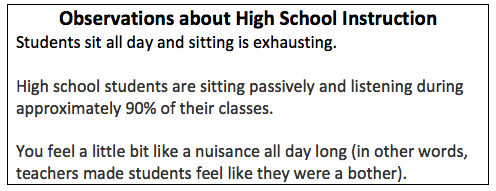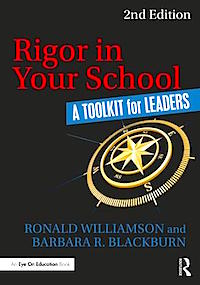Want Authentic Data? Try Shadowing Students
 By Ronald Williamson and Barbara Blackburn
By Ronald Williamson and Barbara Blackburn
School leaders have access to lots of data about their school. Most of that data consists of numbers – things like test scores, graduation rates, student demographics, or survey results. But what about data from direct observation?
Many leaders recognize value of a more authentic data source, one that provides insights into how students experience their school’s program day to day.
One popular authentic data collection tool is the student shadow study. Shadow studies involve selecting students at random and “shadowing” them throughout their day. The observer literally follows the student from class to class and experiences, and charts, a snapshot of the student’s life in school.
The protocol – originally developed in the 1960s and refined over the course of three NASSP studies during the 70s and 80s led by middle school leadership icon John Lounsbury – charts the experience of students every five-to-seven minutes through the day. This allows the observer to capture the ebb and flow of activities in and out of class.
Shadow studies are most successful when a team is used. Each member shadows a different student. At the end of the day they have a set of student experiences that offer insights into what it’s like to be a student in this particular school.
Spending the entire day with a student and documenting their comings and goings using a Shadow Study Observation Form provides interesting insights into the student experience. Of course, students quickly figure out that something is going on. The best approach is to talk with the student and assure them that you are not gathering information about them to report to the office but rather gathering data about the school’s program and what it’s like to be a student here.
A simple data-gathering instrument is typically used, with plenty of room for observer notes:

Sample End of Day Questions
♦ If a new student moved in next door to you, what are three good things about this school that you would tell her or him?
♦ What are some things about the school that you would change if you could?
♦ How do you feel, in general, about your classes? Do they challenge you?
♦ How do you feel, in general, about your teachers? Do they provide enough support for you to be successful?
♦ What did you learn today? How do you think that learning is useful?
Implementing a Shadow Study
Many principals have a common question:
“I like the idea of a shadow study, but I don’t have a full day to do it. Will it work with less time? Also, I wonder if it might work better if I swapped schools with another principal since the student wouldn’t know me.”
There are many ways to conduct a shadow study. You can use part of a day to do the shadowing, or you might spread it out over two days. Occasionally, people are reluctant to shadow students from their own school because they are (unavoidably) gathering information about their adult colleagues.

An Adaptation of a Shadow Study
In a sobering 2014 blog post, the late Grant Wiggins shared the experience of a new high school instructional coach who shadowed two students during two days. It was her first experience with shadowing. The anonymous coach found the experience so revelatory that she wished she had conducted a shadow study when she was a beginning teacher because she would have been a more effective teacher over the intervening years. Her perspective as a coach and a former teacher suggests another option for school leaders as they consider carrying out shadow studies.
In her situation, she shadowed a student each day, but in this case, rather than taking notes based on an observation of the student, she did exactly what the student did. If they were taking notes, she took notes; if they worked on a science experiment, so did she. Based on her experiences, she was able to draw conclusions about the students’ instructional experiences. Here are several:

Imagine how this experience helped her coach and lead teachers in instructional improvement. This adaptation of the first model can also provide leaders with useful (if sometimes hard to hear) information that can inform decisions for school improvement.
Conclusion
Shadow studies provide another kind of data about your school. They add a new dimension. The data gathered can be used to complement the more traditional information you have about your school. But the real value of a shadow study is the opportunity to have an authentic look at the student day, from the student’s perspective. Everyone we know who’s conducted a shadow study is confident you’ll be surprised by what you discover.
Reference
Lounsbury, J. & Johnston, J. H. (1988). Life in the three sixth grades. Reston, VA: National Association of Secondary School Principals.
____________________________________________



































